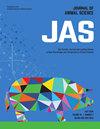Impact of dietary supplementation of beef cows with rumen-protected methionine during the periconceptional period on prenatal growth and performance to weaning
IF 2.7
2区 农林科学
Q1 AGRICULTURE, DAIRY & ANIMAL SCIENCE
引用次数: 0
Abstract
Changes in maternal nutrition during the periconceptional period can influence postnatal growth in cattle. This study aimed to identify the impact of supplementing beef cows with rumen-protected methionine (RP-Met) during the periconceptional period on their female progeny. In exp 1, plasma methionine (Met) levels were analyzed in samples from 10 Angus crossbred, non-lactating beef cows. Cows were randomly assigned to receive 454 g of cottonseed meal with 15 g/d of RP-Met (RPM; Smartamine M, Adisseo) or not (CON) for 5 d and data were analyzed as a completely randomized design with repeated measures. A treatment-by-day interaction was observed (P < 0.001), where plasma Met concentrations increased in the RPM treatment yet remained basal in CON. In exp 2, 114 cows were fed a roughage-based diet and randomized to receive 454 g/d of corn gluten supplemented with 15 g/d of RP-Met (RPM n = 56) or not (CON n = 58) from d -7 to 7 relative to timed artificial insemination (TAI) using sexed semen to obtain females. Amino acids were measured in plasma samples from d -8, 0, and 7 in cows. In the female progeny, body weight, withers height, body length, and heart girth were measured every 60 d from birth through weaning at an average age of 242 ± 5.8 d. Liver, adipose tissue, and longissimus dorsi muscle biopsies were collected at 187.88 ± 5.5 d of age and a subset of 20 random samples (CON = 10; RPM = 10) were selected for RNA-seq on each tissue. data were analyzed as a generalized randomized block design with repeated measures. Methionine was increased (P < 0.01) in plasma from cows in the RPM treatment on d 0 and 7. After calving, 34 female calves (CON = 16; RPM = 18) remained in the study and no difference was observed in birth weights between treatments. Calves were taller at the withers for RPM than CON (P = 0.03; CON = 92 ± 1.0 cm; RPM = 95 ± 1 cm) but there were no effects of treatment on other measures of body size. A total of 30, 24, and 2 differentially expressed genes (DEGs; P < 0.01) were observed in liver, longissimus dorsi muscle, and adipose tissue respectively. In summary, feeding RP-Met to cows in the periconceptional period resulted in female calves that were taller than CON before weaning. There were DEGs in the tissue samples but no other changes in measurements associated with body size. In conclusion, supplementation of RP-Met to beef cows during the periconceptional period caused minor changes in the female offspring before weaning.围孕期饲粮中添加保护瘤胃蛋氨酸对肉牛产前生长和断奶生产性能的影响
围孕期产妇营养的变化会影响牛的产后生长。本研究旨在确定在受孕期添加保护瘤胃蛋氨酸(RP-Met)对肉牛雌性后代的影响。试验1分析了10头安格斯杂交非泌乳肉牛血浆蛋氨酸水平。奶牛随机饲喂454 g棉籽粕,添加15 g/d RP-Met (RPM;Smartamine M, Adisseo)或no (CON)治疗5 d,数据采用重复测量的完全随机设计进行分析。观察到每日治疗的相互作用(P <;在试验2中,114头奶牛以粗饲料为基础,在第7天至第7天随机饲喂454 g/d的玉米蛋白和15 g/d的RP-Met (RPM n = 56)和不饲喂(CON n = 58)的RP-Met (RPM n = 56),相对于使用性授精的定时人工授精(TAI)获得雌性。在奶牛d -8、0和7的血浆样品中测定氨基酸。雌性后代从出生到断奶,平均年龄为242±5.8 d时,每60 d测量一次体重、肩高、体长和心围。在187.88±5.5 d时,随机抽取20个样本进行肝脏、脂肪组织和背最长肌活检。RPM = 10)对每个组织进行rna测序。数据采用重复测量的广义随机区组设计进行分析。蛋氨酸增加(P <;RPM处理奶牛在第0天和第7天血浆中的含量为0.01)。产犊后,34头母牛犊(CON = 16;RPM = 18)仍在研究中,两种治疗方法的出生体重没有差异。RPM组犊牛肩隆高高于CON组(P = 0.03;CON = 92±1.0 cm;RPM = 95±1 cm),但治疗对其他体型测量没有影响。共有30、24和2个差异表达基因(DEGs;P, lt;肝脏、背最长肌和脂肪组织的脂肪含量分别为0.01)。综上所述,围孕期饲喂RP-Met可使断奶前犊牛的身高高于CON。在组织样本中有DEGs,但没有其他与体型相关的测量变化。综上所述,在受孕期向肉牛补充RP-Met对断奶前雌性后代的影响较小。
本文章由计算机程序翻译,如有差异,请以英文原文为准。
求助全文
约1分钟内获得全文
求助全文
来源期刊

Journal of animal science
农林科学-奶制品与动物科学
CiteScore
4.80
自引率
12.10%
发文量
1589
审稿时长
3 months
期刊介绍:
The Journal of Animal Science (JAS) is the premier journal for animal science and serves as the leading source of new knowledge and perspective in this area. JAS publishes more than 500 fully reviewed research articles, invited reviews, technical notes, and letters to the editor each year.
Articles published in JAS encompass a broad range of research topics in animal production and fundamental aspects of genetics, nutrition, physiology, and preparation and utilization of animal products. Articles typically report research with beef cattle, companion animals, goats, horses, pigs, and sheep; however, studies involving other farm animals, aquatic and wildlife species, and laboratory animal species that address fundamental questions related to livestock and companion animal biology will be considered for publication.
 求助内容:
求助内容: 应助结果提醒方式:
应助结果提醒方式:


